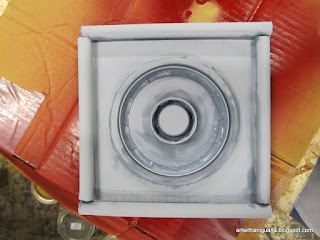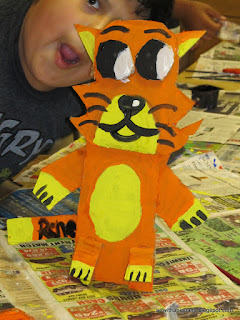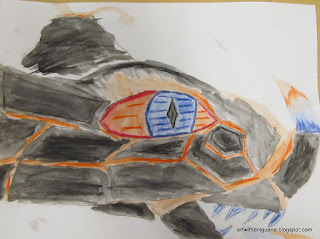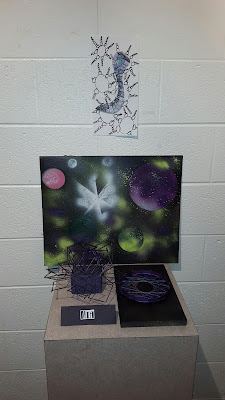This is an acrylic painting I completed on 16x20" canvas for a colleague. It was intended as a gift for their daughter.
Watercolor Pencils
Dragon's Eyes - UP CLOSE!
Students continued their exploration of watercolor media by using watercolor pencils to complete their close ups of a dragon's eye. This project tied in with the legend of the Koi fish.
How to use watercolor pencils for this project.
Visual Metaphor
The 5th graders are reading the book WONDER, by R. J. Palacio right now. One of the sections had a great metaphor. It describes how the main character's sister sees her family structure. I created a quick sketch to illustrate what was in my mind when I read the selection, then I shared it with their Language Arts teachers.
Marine Life Art
Chalk Pastels
Students have been working diligently to complete their Marine Life Art with Chalk Pastels. My first semester students learned about Wyland, his artwork, and mission to inspire others to help care for the environment. Students were allowed to choose their marine life subject matter and create a composition using chalk pastels. Students were also allowed to choose between 9x12" or 12x18" paper for their project.
Art is Out of this World
Spray Paint - Space Art
I've been busy making a few space art paintings. It's a favorite of my students, not to mention fun to create when I have some time and the weather is just right (not too cold, hot or humid). I'm not great at it, but do find it enjoyable to create. These are painted on poster board that is 14" x 22". Periodically I give one or two away in class.
A Different "Type" of Art
With ever changing technology it's easy to forget where we started. In this case, I'm referring to the typewriter. When one thinks of a typewriter you might think of creating or filling in documents and the challenges of correcting mistakes.
A colleague of mine shared a video with me a while ago. I found it inspiring. We all have different abilities. The most important thing is to do our best at whatever we attempt; and never give up on ourselves. You never know who might be touched by your work, actions, or words.
The artist, Paul Smith, featured in this video had cerebral palsy. Despite the physical challenges, he created beautifully detailed artwork using only a typewriter.
What about using it for art?
A colleague of mine shared a video with me a while ago. I found it inspiring. We all have different abilities. The most important thing is to do our best at whatever we attempt; and never give up on ourselves. You never know who might be touched by your work, actions, or words.
The artist, Paul Smith, featured in this video had cerebral palsy. Despite the physical challenges, he created beautifully detailed artwork using only a typewriter.
Paul Smith (September 21, 1921 – June 25, 2007) American Typewriter Artist
Skateboards & STEAM?
Skateboards and STEAM?
(Science, Technology, Engineering, Arts, and Math)
I came across a video today that got me thinking about this topic.
Part of teaching is to connect lessons to real world situations. I love to make connections to other subject matter in my class as it relates to our artwork. This makes learning more relevant. When someone taps into something that is of personal interest we tend to want to get involved and sometimes even dig deeper than we would otherwise (I know I do anyway.).
Part of teaching is to connect lessons to real world situations. I love to make connections to other subject matter in my class as it relates to our artwork. This makes learning more relevant. When someone taps into something that is of personal interest we tend to want to get involved and sometimes even dig deeper than we would otherwise (I know I do anyway.).
Art plays a part in the board design. Graphic artists create all sorts of art that can be seen on skateboards today.
How Skateboards are Made
A High School Art Class Designs Their Own Skateboards
You can also check out the Morro Bay Skateboard Museum to see how boards have changed over the years.
Math and Science is involved when you consider the overall design of the board from wheels, shape, length, etc. The principles of motion also come into play. There's a lot of strategic thinking involved as the skater maneuvers through obstacles in their environment. Check out some of these videos featuring, Bill Robertson, Ph. D. - Dr. Skateboard (Professor, Educator, Skateboarder, Action Scientist).
Simple Machines
Newton's First Law of Motion
Physics of Skateboarding
Read more on Edutopia.
Additional resources:
A Canadian school created an at-risk program that involves graphic design, making skateboards and selling them. For video information click here.
Dive Into ART!
Getting ready for the start of a new school year brings new ideas! I have been busy working to create an exciting new look for the hallway.
We will be studying the artist, Wyland this year, which is where the inspiration for this project began. This piece came together using a variety of materials, many recycled, to imitate nature in an artistic way.
How it all started...
Foam and random paperboard packing materials hot glued together.
Some "Great Stuff" expanding foam to create more texture.
I used Createx acrylic air brush paint to add color.
I made extra pieces from expanding foam and cardboard.
Fine Arts Frenzy 2015
I visited the final day of this year's Fine Arts Frenzy. Kids were exploring science, math and art. Mrs. Howard did a great job with the kids! Here are a some examples of their work.
Lids, Lights, Foam and More
This summer I had the opportunity to work on the set for a local production of Annie Jr. Sometimes the most unlikely materials come together to create some of most interesting things. We needed decorative corners for our entrance to the Roxy Theatre.
The next challenge was to make lighted signs for this scene. This involved reusing some very study foam core signboard, a little math (to figure out how to space the bulbs, etc.), some painting and a whole lot of drilling.
 |
| Plastic lids, cardboard, and small cardboard tubes joined with hot glue |
 |
| A little flat latex paint |
 |
| Added to the set |
Student Gifts of Art
Cardboard Relief Sculptures
What do you do when you've collected a lot of extra cardboard and some students have finished early with their other projects? We created cardboard relief sculptures! The kids came up with some really cool ideas. There were many different interpretations of animals, etc. It was great!
What was even more impressive was how students were looking at scraps from other projects and finding ways to use them in their own art. When you reach the point where they don't think they have to start with a new item for each thing they make...PROGRESS!

What was even more impressive was how students were looking at scraps from other projects and finding ways to use them in their own art. When you reach the point where they don't think they have to start with a new item for each thing they make...PROGRESS!

Subscribe to:
Posts (Atom)






















































